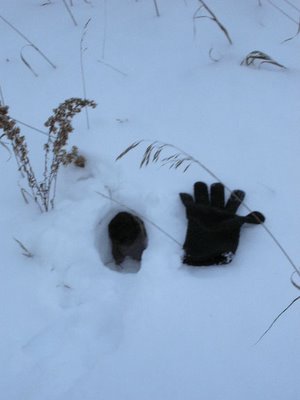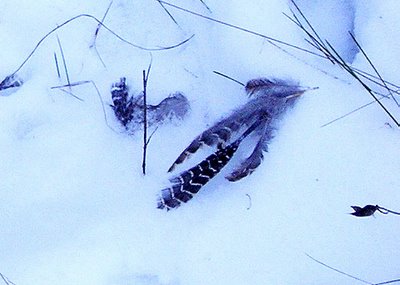Welcome to the 10th edition of I and the Bird, the blog carnival of birds and birding. This edition offers a fine selection from the blogosphere, celebrating the diversity of the bird species around the globe, and considering the questions that birders everywhere ask.
What's that Bird?
There are identification problems that seem intractable to beginning birders. Telling one gull species from another ranks right up there for me. But this instructive post on the differences between the
Thayer's gull and the herring gull from
Mike's Soap Box shows us the way.
Hawk? But what kind? Pascal of
Research at a snail's pace writes about the sharp-shinned hawk, and how its appearance changes as it matures in
Sharp-Shinned Hawk Age Coloration.
Could it be a Cooper's? Sometimes a nice big beautiful raptor lands right on the windowsill. And some of those times someone has a camera ready. It happened to Signor Ferrari of
The Blue Parrot, and he posted the picture in his
Friday Critter Blogging.
Knowing BirdsKnowing one bird from another can come like an epiphany. Mike at
10,000 Birds writes about a subject near and dear to my heart, knowing sparrows, in
Seeing Birds Better. My own small offering,
The Jizz, is about seeing shrikes better.
Who's That Bird?
But there's more to it than just knowing what.
Holistic Birding Revisited, a post I came across at the
Blurry-eyed Birder, reminds us that a bird is more than a collection of field marks, as these next posts demonstrate. Cindy of
Woodsong writes about the talented chickadee in her beautifully illustrated
Bird Brains. From
Bird TLC, a story about Beauty, an eagle who transcends difficult circumstances and maintains her eagle essence in
Good overrides evil. From
Birdchick Blog,
Subject Line, a look at a book from the 60's about bird feeding, and some strange notions indeed--a reminder of some things birds are not.
Where's that Bird?Knowing who and what birds are sometimes helps us know where they are--sometimes not. Usually luck is involved too.
First TimesCommon or rare, there's a first time for everyone. Gwyn of
Bird Brained Stories,
praises the birding gods, and the birder network, for her first
American Avocet. On
an unseasonably warm day TroutGrrrl of
Science and Sarcasm spots her first fox sparrow. And
Night of the Kingfisher submitted this story,
The Luck of the Duck, or Serendipitous Birding, of going out not expecting much, and ending up with three additions to his life list.
SerendipityOver at
Aurora Borealis I found this tale of
a bird turning up exactly when it was wanted. Duncan of
Ben Cruachan Blog goes out to find a particular bird, never finds it, but ends up having a
A Grand Day Out all the same. (Note the new link for Ben Cruachan Blog--technical difficulties forced a move, which may be permanent--watch for developments.) I found this story at
The City Birder and included it because it tells a tale a lot of birders can relate to.
My Nemesis Bird is about that one bird that always shows up where the birder has been but never where he is.
Urban BirdsThe hustle and bustle of city life can blind urbanites to the natural world around them--but there are birds there too, as the next series of posts demonstrates.
A young birder from the
Bird Ecology Study Group in Singapore writes about
the sunbirds that visit both his grandfathers' gardens. GrrlScientist's
Birds in the News sent me to
this site, devoted to the marvelous monk parrots of Brooklyn.
Birding is not a Crime reports on
some excellent birding in a new park, on the site of an old airport.
Search and Serendipity also finds
great birding in an unlikely spot, and some mammaling too! From
A DC Birding Blog comes another kind of urban birding story:
Birds at the National Gallery--enjoying an exhibit of the incredible work of Audubon.
Birds on the MoveFrom
Crows Really are Wise, a migration stopover I'd never considered: a drilling platform in the Gulf of Mexico turns into a birder's paradise during the spring migration, in
Birds and Offshore Oil Platforms.
Bill of the Birds, editor of
Bird Watcher's Digest,
sends this report from the Big Sit--a marathon of migration watching that takes place in Ohio. Here's
a link to a page on the Bird Watcher's Digest site that describes how the event works. Nuthatch of
Bootstrap Analysis reports on the
chickadee invasion!, the current irruption of these guys, and about what's it's like to band them--they aren't the sweeties you might think.
Tony G sends this migration story,
American Kestrels are Back for the Winter Months, from
The Nature Writers of Texas.
Homebody BirdsClare at
The House and Other Arctic Musings celebrates
Aqiggiq (the ptarmigan), one of the few species that will spend the winter with him in Arctic Bay. And Charlie of
Charlie's Bird Blog enjoys a day with the
resident birds of Denver and one strange looking fox, in late October.
Bird Losses--Bird GainsThese last two are stories about where birds are back and where they may soon be gone. From
Sphere, Tom Andersen on the Long Island Sound writes about the
Piping Plover Lovers, concern for the precarious position this bird finds itself in, and an investigation into the controversy over how to pronounce plover. Finally, on a happier note, this post from
Sand Creek Almanac, celebrating the
Return of the Bald Eagle.
Thanks to Mike for trusting me with his carnival, to TonyG for his help, and to all of the contributors, without whom...... I and the Bird #11,
November 24 November 23 (early in honour of American Thanksgiving), will be hosted by
The House and Other Arctic Musings. Send
your submissions to
Clare or
Mike (father of
I and the Bird) by
early November 22.












 Back at the end of October, in the post Hermit Thrush, I reported a sighting of a slightly late migrant hermit thrush in the cedar bush, pictured at the right. Yesterday, in the dusk-like conditions of a snowy day in the middle of December, there it was again, in the cedar bush.
Back at the end of October, in the post Hermit Thrush, I reported a sighting of a slightly late migrant hermit thrush in the cedar bush, pictured at the right. Yesterday, in the dusk-like conditions of a snowy day in the middle of December, there it was again, in the cedar bush.
























 If you blog about birds and birding--even if you've just written one post about wild birds--consider submitting it to the carnival, today. Send me an e-mail with a brief description of, and link to your post.
If you blog about birds and birding--even if you've just written one post about wild birds--consider submitting it to the carnival, today. Send me an e-mail with a brief description of, and link to your post.







